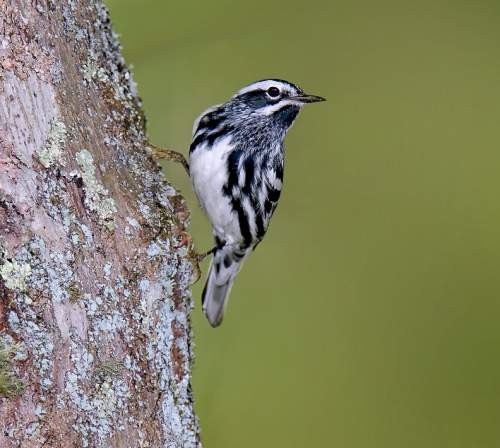Home › Ecuadorian cacique › Black-and-white warbler - Mniotilta varia
The black-and-white warbler (Mniotilta varia) belongs to the family of New World warblers, the Parulidae.The black-and-white warbler is distributed in North America, South America and the Caribbean Islands. These warbler species are fully migratory birds. These warblers are monotypic.
Appearance, physical description and identification
The black-and-white warbler (Mniotilta varia) is a stocky, relatively short-tailed New World warbler, measuring 10 to 13 cm in length and weighing 9 to 15 grams.These black-and-white warbler species have black and white striped plumage. The crown is dark with a central white streak. There is a bold white supercilium and a black lore extending beyond the eye.
The upperparts and the flanks are boldly striped black and white. The underparts have milder striping. The vent and undertail regions have dark bars. The females and juveniles have duller streaking.
The bill is long, pointed and grayish. The legs and feet are blackish gray. The irises are dark. There is a whitish eye-ring. The warbler call is a loud "chee.. chee.. chee.. chee" sound.
 |
| 1.Black-and-white warbler - Mniotilta varia Picture by Wolfgang Wander |
 |
| 2.Black-and-white warbler - Mniotilta varia Photo by William H. Majoros |
 |
| 3.Black-and-white warbler - Mniotilta varia Image by William H. Majoros |
Origin, geographical range and distribution
The breeding populations of the black-and-white warbler species are distributed in southern, southwest and southeast Canada and central and eastern USA.The wintering warbler populations occur in southern USA (Florida, southern Texas), central and southern Mexico, Belize, Guatemala, Honduras, El Salvador, Nicaragua, Costa Rica, Panama, Venezuela, Colombia, Ecuador, Peru and the Caribbean Islands.
Vagrant warblers occur in Faroe Islands (Denmark), Ireland and United Kingdom. Passage birds are found in central and south-central USA, southeast USA (Louisiana, Alabama, Georgia, South Carolina) and north Mexico.
Ecosystem and habitat
The black-and-white warbler species have moderate forest dependence. They normally occur in altitudes between 0 to 1000 meters.The natural ecosystems and habitats of the warbler species include tropical and subtropical moist lowland forests, boreal forests, tropical and subtropical moist montane forests, deciduous forests and dry shrublands.
Diet and feeding behavior
The diet of the black-and-white warbler species consists mainly of insects. Caterpillars, insects, moths, butterflies, beetles, ants, spiders, fruits and berries are their primary food.These species are mostly arboreal. Foraging on tree trunks and inner branches, they glean insects from the foliage. During breeding and migration, larval insects and caterpillars are the preferred diet.
Reproduction and breeding habits
The breeding season of these black-and-white warbler species is from April to June in most of their breeding range. They are monogamous solitary breeders. They males are highly territorial and perform display flights.The breeding ecosystem includes boreal forests and montane forests. They mostly nest on the ground, among the roots of trees and in crevices on tree stumps.
The female black-and-white warbler constructs the cup-shaped nest with grass, leaves and rootlets. The nest is lined with fine grass, feathers, moss and rootlets. The female incubates the eggs.
The clutch may contain four to five eggs. The male may feed the female during incubation. The chicks hatch out after 10 days and the parents take care of the hatchlings. The young birds fledge after 10 days.
Migration and movement patterns
The black-and-white warbler species are fully migratory birds. They breed in southern, southwest and southeast Canada and central and eastern USA. They migrate southwards for wintering during July and August.These warblers winter in southern regions of North America, Northern parts of South America and the Caribbean Islands. The return migration to the breeding grounds occurs in early summer.
Black-and-white warbler - Quick Facts
- Scientific name: Mniotilta varia
- Species author: (Linnaeus, 1766)
- Synonyms/Protonym: Motacilla varia Linnaeus, 1766
- Family: Parulidae › Passeriformes › Aves › Chordata › Animalia
- Vernacular names: English: Black-and-white warbler, Chinese: 黑白森莺, French: Paruline noir et blanc, German: Kletterwaldsänger, Spanish: Reinita trepadora, Russian: Чёрно-белая древесница, Japanese: シロクロアメリカムシクイ
- Other names: Black-and-white Warbler
- Distribution:North America, South America, Caribbean Islands
- Diet and feeding habits: insects, fruits, berries
- IUCN status listing: Least Concern (LC)
Conservation and survival
The global population size of the black-and-white warbler (Mniotilta varia) has not been quantified. The overall population trend of the species is reported to be declining.In most of its range, this warbler species is reported to be uncommon to common. The generation length is 4.6 years. Its distribution size is about 11,500,000 sq.km.
Ecosystem degradation, ecosystem conversion, deforestation, adverse weather and climate change are the main threats that may endanger the survival of the warbler species.
IUCN and CITES status
The black-and-white warbler (Mniotilta varia) species does not approach the thresholds for being Vulnerable either under the range size criterion or under the population trend criterion or under the population size criterion.The IUCN (International Union for Conservation of Nature) has categorized and evaluated the species and has listed it as of "Least Concern (LC)".
The CITES (Convention on International Trade in Endangered Species of Wild Fauna and Flora) status is ‘Not Evaluated’ for the black-and-white warbler (Mniotilta varia).
1.Image source: http://www.pbase.com/wwcsig/image/50151128 (cropped)
Author: Wolfgang Wander | License: CC BY-SA 3.0 and GFDL 1.2 as on 1/9/19
2.Image source: https://en.wikipedia.org/wiki/File:Black-and-white-warbler-1.jpg (cropped)
Author: William H. Majoros | License: CC BY-SA 3.0 as on 1/9/19
3.Image source: https://commons.wikimedia.org/wiki/File:8G7D2762.jpg (cropped)
Author: William H. Majoros | License: CC BY-SA 3.0 as on 1/9/19
Link to Creative Commons copyright licenses
Updated Jan 8, 2019
Recently updated and current topic in Bird World: Black-and-white warbler - Mniotilta varia.
